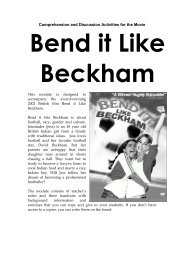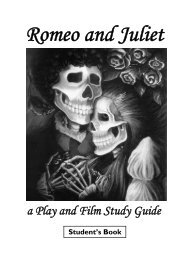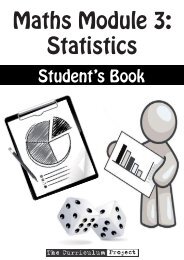Student's Book â Dec 2009 (5.9mb) - The Curriculum Project
Student's Book â Dec 2009 (5.9mb) - The Curriculum Project
Student's Book â Dec 2009 (5.9mb) - The Curriculum Project
You also want an ePaper? Increase the reach of your titles
YUMPU automatically turns print PDFs into web optimized ePapers that Google loves.
Modern East TimorFretilin helped East Timor gain independence from Portugal in November 1975. However onlya few weeks later, Indonesian troops occupied the country, with the support of Australia. It isestimated that 100,000 people in East Timor died during the start of the conflict, from fighting,disease and famine.At first Falantil (Fretilin’s military wing) had some success. However Indonesia was still ableto keep firm control over East Timor until 1991. In 1991, Indonesian troops killed an estimated200 protesters in East Timor. <strong>The</strong> killings weakened Indonesia’s control over the region andembarrassed Indonesia internationally. Change finally happened when Suharto’s regime inIndonesia fell.<strong>The</strong> new Indonesian president, B.J. Habibie, announced a referendum in East Timor to askpeople if they wanted independence. <strong>The</strong> referendum was supported by the United Nations.<strong>The</strong> results were clear. On August 30th, 1999, 78.5 per cent of voters chose independencefrom Indonesia.Indonesia responded to the results of the referendum with violence. An estimated 1,400 Timoresepeople were killed and another 300,000 people fled to West Timor as refugees. During this time,important infrastructure was destroyed including bridges, government buildings, shops andtelecommunication and power installations.It took intervention by a multinational peacekeeping force, INTERFET (the International Forcefor East Timor) to stop the violence. <strong>The</strong> country was administered by the United Nations fromSeptember 1999 until 2002.On 20 May 2002, the United Nations gave control of East Timor to the Timorese people. <strong>The</strong>first president was the former leader of Falantil, Xanana Gusmao, and the first prime ministerwas Mari Alkatiri, the former leader of Fretilin.Post-Independence East TimorSome problems that existed in East Timor prior to independence continued afterwards. Povertywas one of the biggest challenges the new democracy had to face and people’s frustration overcontinuing economic problems led to riots in the capital, Dili.Today, the East Timorese government is exploring both external and internal methods ofimproving the economy, but progress is slow.<strong>The</strong>re are oil and gas reserves in the Timor Sea which may help develop the country’s economyin the future. Coffee is another of East Timor’s resources. East Timorese coffee is some of themost popular coffee in the world because it is organically grown. (<strong>The</strong> country’s economy ispartially the cause of this, since coffee farmers simplycan’t afford fertilisers or pesticides.) <strong>The</strong> coffee industrycurrently employs about 50,000 people and productionis increasing.Although people have been scared away fromvisiting East Timor because of the political unrest there,tourism is another possible source of income for thecountry.At the moment, East Timor is very dependent on foreignaid to develop the economy. Australia is one of thecountry’s biggest donors. Between 2008 and <strong>2009</strong>,Australia provided $96 million in OfficialDevelopment Assistance funds.68



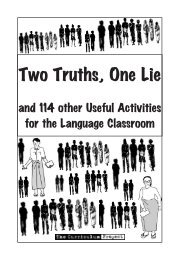
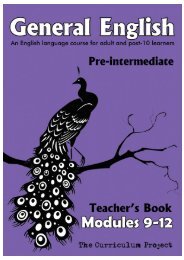
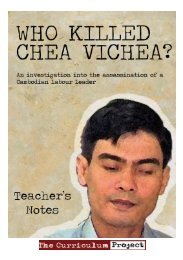

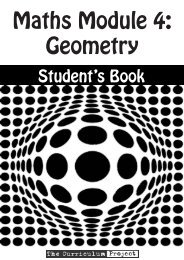
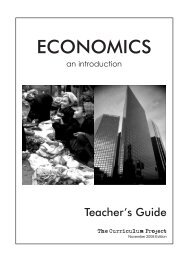
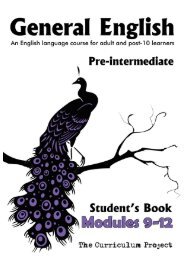

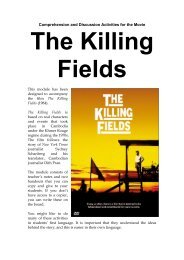
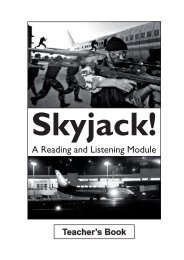
![[Eng] Nov 2012 DRAFT - The Curriculum Project](https://img.yumpu.com/45590859/1/184x260/eng-nov-2012-draft-the-curriculum-project.jpg?quality=85)
